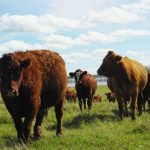Tips on culling
When it’s time to cull cows, look to performance records, as well as calf pens, a North Dakota State University beef specialist has advised.
“Culling involves several steps,” said Kris Ringwall. “If you have good performance data on your cows, moving down those steps is easier.” Ringwall is a beef specialist at NDSU’s Dickinson Research Extension Centre.
Ringwall says the first round of culling should eliminate several obvious problems:
- All open cows.
- Cows that lost calves due to excessive calving difficulty.
- Cows structurally unsound because of hoof, leg, udder or other health problems.
- Emaciated cows.
Read Also

VIDEO: Green Lightning and Nytro Ag win sustainability innovation award
Nytro Ag Corp and Green Lightning recieved an innovation award at Ag in Motion 2025 for the Green Lightning Nitrogen Machine, which converts atmospheric nitrogen into a plant-usable form.
The next step is to eliminate cows that calved later than the rest of the herd. Look to cull cows that calved after the start of the fourth or third calving cycle.
“If you can condense the calving interval of your cows, you’ll have an easier job managing and marketing the calf crop because they’ll all be closer in age and size,” he said.
Producers can also look at the most probable producing ability rating for their cows. That rating estimates the performance of the cow’s next calf, taking into account the age of the cow and the number of calves the cow has weaned.
Cows with lower ratings should be culled first.
Ringwall also suggested producers take a look at the oldest cows in the cow herd and cull those that are in poor condition or that have poor teeth. “These are cows that are going to have difficulty withstanding another winter,” he said.
Typically, about 10 percent of the cow herd will be made up of cows that are 10 years old or older.
A rebounding cattle market combined with fewer cows in the herd because of difficult conditions last winter may encourage producers to be less selective in culling.
“If a producer decides to keep a cow that would be normally culled, that has to be a very carefully thought-out decision. Problems that we can avoid by culling can be very expensive, and keeping that cow for another year might not be profitable at all,” he said.
– North Dakota State University















